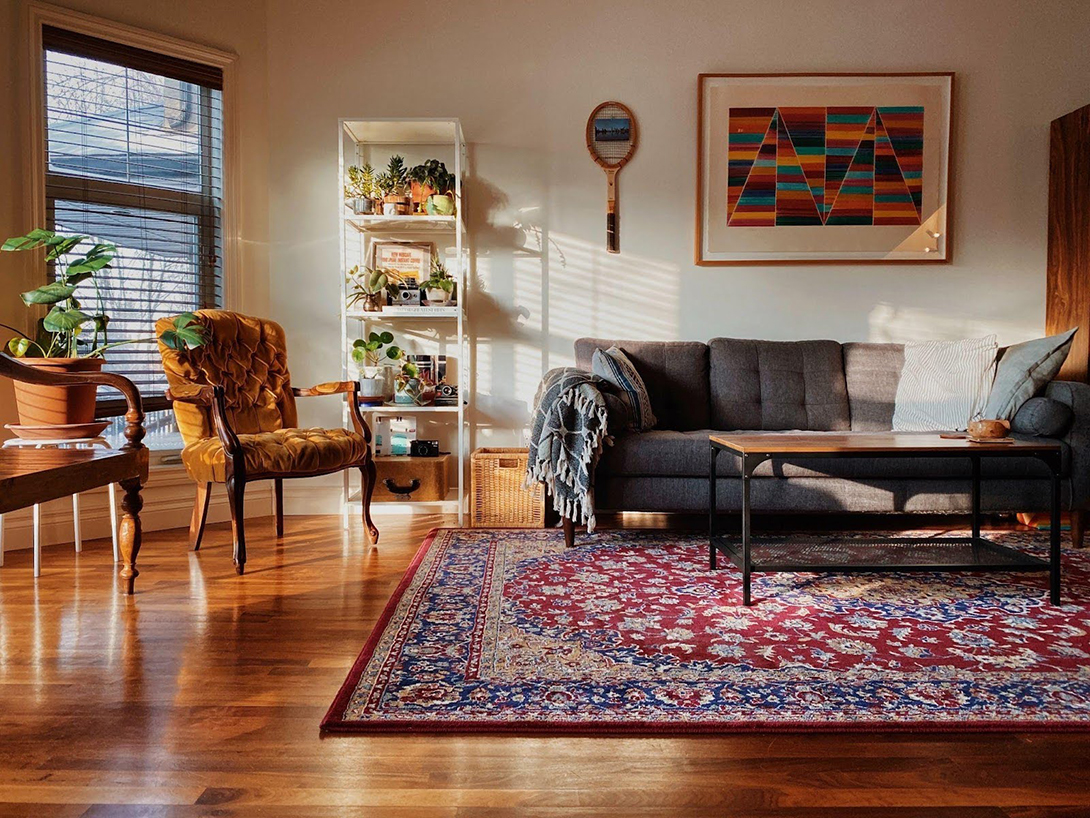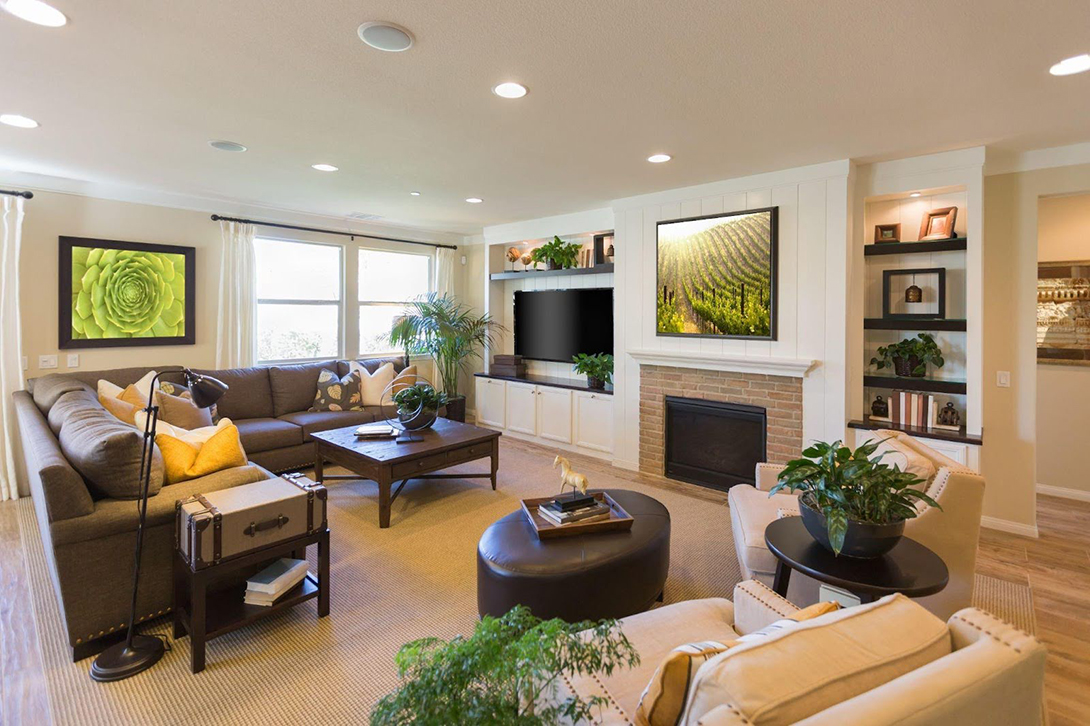Decorating your living room is about more than just picking furniture and paint colors, it’s about creating a space that reflects your style while maintaining functionality and flow. As someone with a design background, I’ve helped many homeowners transform their living rooms into stylish retreats. Over the years, I’ve transitioned from helping homeowners decorate their personal spaces to designing home flips for those getting ready to sell. This experience has taught me how to merge personal style with broad market appeal. Here’s how you can do the same, whether you’re looking to refresh your living room or prepare it for the market.
-
Start with a Neutral Base
One of the first steps into decorating any room, especially a living room, is choosing a color palette. I always recommend starting with a neutral base. Neutral tones – think grays, beiges, whites, and soft creams – act as a clean canvas, allowing other elements in the room to stand out. Neutral colors also tend to appeal to a broader audience, which is especially important if you’re selling your home. -
Incorporate Pops of Color
While a neutral base creates balance, small doses of color can inject personality and vibrancy into the room. Choose a color scheme that works well with your base – whether it’s bold jewel tones, soft pastels, or earthy shades – and bring it to life with throw pillows, artwork, rugs, or vases. Remember, when staging a home for sale, avoid overwhelming the space with too many colors. Subtle accents are more appealing to buyers. -
Layers in Textures
Texture is just as important as color when it comes to adding depth to your living room. Combining a variety of textures, such as soft fabrics, plush rugs, sleek metals, and natural wood, creates an inviting, layered look. Don;t be afraid to mix materials like velvet, linen, leather, and wool to create a comfortable and luxurious feel. -
Maximize Natural Light
Natural light can dramatically enhance the look and feel of your living room. It makes the space feel larger, brighter, and more welcoming. To make the most of natural light, use sheer curtains or light-colored blinds that allow light to flow through. Avoid heavy drapes that can darken the room and make it feel smaller. Also, placing mirrors opposite windows helps reflect natural light, amplifying its effect.
-
Keep It Clutter-Free
A clutter-free living room instantly feels more spacious and inviting. Whether you’re decorating your home for your own enjoyment or preparing to sell, minimize clutter by removing unnecessary items and focusing on purposeful decor. In a staged home, buyers want to see the potential of the space, not your personal belongings. Use stylish storage solutions, such as ottomans, baskets, or sleek cabinets, to keep essentials organized while maintaining a clean look. -
Create Conversation Zones
The living room is often the heart of social gatherings, so it’s important to create spaces that encourage conversation. Avoid pushing furniture against the walls – this can make the room feel disconnected. Instead, arrange seating close together to create intimate conversation areas. For larger living rooms, consider creating multiple conversation zones, such as a main seating area and a reading nook. -
Add Greenery
Plants bring life, texture, and a pop of color into the living room. They soften harsh lines and add an element of nature that makes the space feel more calming. Whether you opt for a large potted plant in the corner of a collection of smaller succulents on a side table, plants are a great way to add visual interest and freshness to the room. Plus, they’re an affordable decor solution that appeals to almost everyone. -
Showcase Your Style Without Overdoing It
Personal style is important in a living room, but if you’re selling your home, too much personalization can deter buyers. Focus on a few statement pieces – whether it’s an art piece, a unique light fixture, or a chic coffee table – that reflect your style without overwhelming the space. This keeps the room inviting but neutral enough for buyers to imagine themselves living there. -
Focus on Furniture Scale
One of the most common mistakes in decorating a living room is choosing furniture that is either too big or too small for the space. For example, a massive sectional sofa may overwhelm a smaller living room, while tiny furniture can make a larger room feel incomplete. Be mindful of the proportions in the room and opt for pieces that balance the space. A well-proportioned room feels more comfortable and visually appealing. -
Create a Focal Point
Every living room should have a focal point – an area or feature that draws the eye and anchors the space. This could be a fireplace, a large piece of artwork, or even a beautifully styled coffee table. Once you’re determined your focal point, arrange furniture and decor in a way that emphasizes it. If you don’t already have a natural focal point, create one with a statement light fixture or a gallery wall. -
Add Personal Touches (with Care)
The living room is a space for relaxation and gathering, so comfort should always be a top priority. Choose a plush seating with soft cushions and cozy throws to make the room inviting. Layer area rugs to add softness underfoot, especially on hard flooring. Furniture and decor that strike a balance between beauty and comfort will make the living room a space people want to spend time in. -
Emphasize Comfort
The living room is a space for relaxation and gathering, so comfort should always be a top priority. Choose plush seating with soft cushions and cozy throws to make the room inviting. Layer area rugs to add softness underfoot, especially on hard flooring. Furniture and decor that strike a balance between beauty and comfort will make the living room a space people want to spend time in. -
Incorporate Statement Lighting
Lighting is a key element of living room design. While natural light is ideal, you’ll also want to focus on your lighting fixtures. Choose a stylish chandelier or pendant light for overhead lighting, then add floor lamps and table lamps for tasks lighting and ambiance. Layering different types of lighting allows you to create the perfect mood for any occasion, whether you’re hosting guests or relaxing with a book. -
Invest in Quality Pieces
When decorating, it’s tempting to fill your living room with trending or low-cost furniture, but it’s worth investing in a few high-quality, timeless pieces that will stand the test of time. A well-made sofa, sturdy coffee table, or elegant armchair can last for years and serve as the foundation for the room’s style. You can always update accents like pillows and decor to refresh the space without breaking the bank. -
Balance Symmetry and Asymmetry
In design, symmetry is pleasing to the eye and creates a sense of order, but too much symmetry can feel rigid. Mix it up by incorporating a blend of symmetrical and asymmetrical elements. For example, you might pair matching end tables on either side of a sofa but place different lamps on each. This combination of balance and surprise makes a living room feel both orderly and interesting.
Decorating a living room can be both fun and functional. Whether you’re designing a space for everyday living or staging it for sale, these tips can help you strike the perfect balance between style, comfort, and market appeal. With my experience in both interior designing and preparing homes for sale, I’m here to help you create a living room that reflects your unique taste while appealing to a broad audience.

